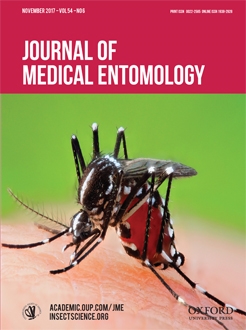The mosquitoes Aedes (Stegomyia) aegypti (L.)(Diptera:Culicidae) and Ae. (Stegomyia) albopictus (Skuse) (Diptera:Culicidae) transmit dengue, chikungunya, and Zika viruses and represent a growing public health threat in parts of the United States where they are established.To complement existing mosquito presence records based on discontinuous, non-systematic surveillance efforts, we developed county-scale environmental suitability maps for both species using maximum entropy modeling to fit climatic variables to county presence records from 1960–2016 in the contiguous United States. The predictive models for Ae. aegypti and Ae. albopictus had an overall accuracy of 0.84 and 0.85, respectively. Cumulative growing degree days (GDDs) during the winter months, an indicator of overall warmth, was the most important predictive variable for both species and was positively associated with environmental suitability. The number (percentage) of counties classified as environmentally suitable, based on models with 90 or 99% sensitivity, ranged from 1,443 (46%) to 2,209 (71%) for Ae. aegypti and from 1,726 (55%) to 2,329 (75%) for Ae. albopictus. Increasing model sensitivity results in more counties classified as suitable, at least for summer survival, from which there are no mosquito records. We anticipate that Ae. aegypti and Ae. albopictus will be found more commonly in counties classified as suitable based on the lower 90% sensitivity threshold compared with the higher 99% threshold. Counties predicted suitable with 90% sensitivity should therefore be a top priority for expanded mosquito surveillance efforts while still keeping in mind that Ae. aegypti and Ae. albopictus may be introduced, via accidental transport of eggs or immatures, and potentially proliferate during the warmest part of the year anywhere within the geographic areas delineated by the 99% sensitivity model.
How to translate text using browser tools
21 September 2017
Modeling the Environmental Suitability for Aedes (Stegomyia) aegypti and Aedes (Stegomyia) albopictus (Diptera: Culicidae) in the Contiguous United States
Tammi L. Johnson,
Ubydul Haque,
Andrew J. Monaghan,
Lars Eisen,
Micah B. Hahn,
Mary H. Hayden,
Harry M. Savage,
Janet McAllister,
John-Paul Mutebi,
Rebecca J. Eisen
ACCESS THE FULL ARTICLE
It is not available for individual sale.
This article is only available to subscribers.
It is not available for individual sale.
It is not available for individual sale.

Journal of Medical Entomology
Vol. 54 • No. 6
November 2017
Vol. 54 • No. 6
November 2017
Aedes aegypti
Aedes albopictus
environmental suitability
MaxEnt
risk model





